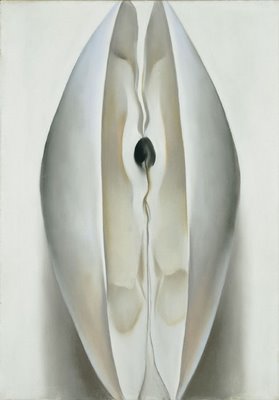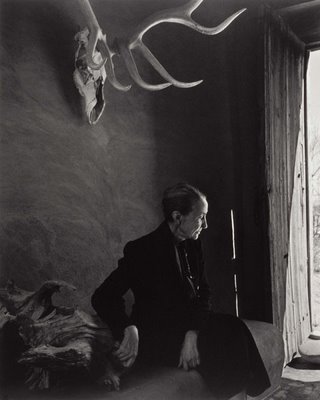Wadsworth acquires an O’Keeffe
Plus how photography made O’Keeffe a star

Hartford’s Wadsworth Atheneum announced last week that it had acquired Georgia O’Keeffe’s 1926 pastel “Slightly Open Clam Shell” (pictured above).
Which we’ll use as an occasion to finally post this review of the Portland Museum of Art’s exhibit “Georgia O’Keeffe and the Camera” from last summer:
 How did Georgia O’Keeffe become one of the most famous American artists of her era? Only Edward Hopper rivals her from the beginning of the 20th century to just after World War II, when Abstract Expressionism burst onto the scene.
How did Georgia O’Keeffe become one of the most famous American artists of her era? Only Edward Hopper rivals her from the beginning of the 20th century to just after World War II, when Abstract Expressionism burst onto the scene.
Chalk it up to her catchy flowers and skulls, the richness of her lyrically abstracted realism, her singularity as a woman in a male-dominated (art) world – and photography. “Georgia O’Keeffe and the Camera: The Art of Identity” at the Portland Museum of Art sharply and convincingly argues that photography promoted her public persona and helped make O’Keeffe a household name.
It began in 1917 with her affair with New York dealer, taste-maker and photographer Alfred Stieglitz, when she was 29 and he 53 and married. They shacked up in 1918 and married (shortly after his divorce) in 1924.
Stieglitz – and the 350 photos he shot of O’Keeffe over 20 years – focused the art world’s attention on her. Early on he portrayed her close up, artfully buttoning her coat, or with her hair disheveled and semi-dressed as if she had just had sex. (The museum is overly polite by not including any of Stieglitz’s nudes of O’Keeffe.) She painted naked ladies and abstractions of luscious folds around cave-like openings. He published exhibition pamphlets saying she revealed “the intimacies of love’s juncture, with the purity and the absence of shame that lovers feel in their meeting.” Critics ran with it.
But O’Keeffe, who craved to be taken seriously as an artist, came to feel pigeonholed. In your mind compare Stieglitz’s shots of his erotic muse to classic photos of Pablo Picasso or Jackson Pollock (two other major 20th century artists promoted by photography) as sexy, macho, volcanoes of creativity.

Her flower paintings were apparently her attempt to change the subject. “For her they were all exercises in formal composition,” says Portland Museum curator Susan Danly, who organized the show with Georgia O’Keeffe Museum curator Barbara Buhler Lynes. Observers just saw more of the same sensuality in the luscious petals and leaves of paintings like Corn, No. 2 (1924). It’s the only great painting in a show dominated by striking photography. The curators nicely pair canvases with photos (i.e. a painting hung next to a shot of it in O’Keeffe’s studio), but the paintings tend to illustrate points rather than showing O’Keeffe at her best.
Her public image finally shifted when she began summering in New Mexico in 1929, and painted arid mountains, scrawny trees and skulls (from sex to death). She moved there in 1949, three years after Stieglitz’s death.
In 1937, Ansel Adams photographed her smiling with a ranch hand. They are silhouetted against roiling clouds, like a shot from some Hollywood Western with O’Keeffe cast as a flinty pioneer – an American icon. She favored denim in her daily attire and late in life had a closet full of colorful Marimekko dresses, Danly says, but she cultivated her new stark, no-nonsense public image by often dressing in plain black and white when she was being photographed.
Big name photographers visited – Eliot Porter, Irving Penn. Philippe Halsman, Arnold Newman. They focused on her, her stark surroundings, her collections of rocks and bones. In 1956, Yousuf Karsh photographed her seated in profile in a dim room, lit by the sun from an open door at right. She holds onto a chunk of knotty wood while a skull hanging on the wall behind her watches over her. For the cover of Life magazine in 1967, John Loengard photographed her in profile on the roof of her home in front of a chimney that looks like a tombstone. Desert and sky open up behind her.
But America’s long been suspicions of powerful, independent ladies. Andy Warhol channeled this in his Halloween orange and black silkscreen of her from circa 1979, but you can already sense it in Karsh and Leonard’s shots. With all the black and bones, the photographers subtly transform her from plucky pioneer into her final public incarnation: old witch.
“Georgia O’Keeffe and the Camera: The Art of Identity” at the Portland Museum of Art, June 12 to Sept. 7, 2008.
Pictured from top to bottom: Georgia O'Keeffe, “Slightly Open Clam Shell,” 1926; Arnold Newman, "Georgia O'Keeffe, Ghost Ranch, New Mexico,” 1968; and Yousef Karsh, “Georgia O’Keeffe,” 1956.

Hartford’s Wadsworth Atheneum announced last week that it had acquired Georgia O’Keeffe’s 1926 pastel “Slightly Open Clam Shell” (pictured above).
Which we’ll use as an occasion to finally post this review of the Portland Museum of Art’s exhibit “Georgia O’Keeffe and the Camera” from last summer:
 How did Georgia O’Keeffe become one of the most famous American artists of her era? Only Edward Hopper rivals her from the beginning of the 20th century to just after World War II, when Abstract Expressionism burst onto the scene.
How did Georgia O’Keeffe become one of the most famous American artists of her era? Only Edward Hopper rivals her from the beginning of the 20th century to just after World War II, when Abstract Expressionism burst onto the scene. Chalk it up to her catchy flowers and skulls, the richness of her lyrically abstracted realism, her singularity as a woman in a male-dominated (art) world – and photography. “Georgia O’Keeffe and the Camera: The Art of Identity” at the Portland Museum of Art sharply and convincingly argues that photography promoted her public persona and helped make O’Keeffe a household name.
It began in 1917 with her affair with New York dealer, taste-maker and photographer Alfred Stieglitz, when she was 29 and he 53 and married. They shacked up in 1918 and married (shortly after his divorce) in 1924.
Stieglitz – and the 350 photos he shot of O’Keeffe over 20 years – focused the art world’s attention on her. Early on he portrayed her close up, artfully buttoning her coat, or with her hair disheveled and semi-dressed as if she had just had sex. (The museum is overly polite by not including any of Stieglitz’s nudes of O’Keeffe.) She painted naked ladies and abstractions of luscious folds around cave-like openings. He published exhibition pamphlets saying she revealed “the intimacies of love’s juncture, with the purity and the absence of shame that lovers feel in their meeting.” Critics ran with it.
But O’Keeffe, who craved to be taken seriously as an artist, came to feel pigeonholed. In your mind compare Stieglitz’s shots of his erotic muse to classic photos of Pablo Picasso or Jackson Pollock (two other major 20th century artists promoted by photography) as sexy, macho, volcanoes of creativity.

Her flower paintings were apparently her attempt to change the subject. “For her they were all exercises in formal composition,” says Portland Museum curator Susan Danly, who organized the show with Georgia O’Keeffe Museum curator Barbara Buhler Lynes. Observers just saw more of the same sensuality in the luscious petals and leaves of paintings like Corn, No. 2 (1924). It’s the only great painting in a show dominated by striking photography. The curators nicely pair canvases with photos (i.e. a painting hung next to a shot of it in O’Keeffe’s studio), but the paintings tend to illustrate points rather than showing O’Keeffe at her best.
Her public image finally shifted when she began summering in New Mexico in 1929, and painted arid mountains, scrawny trees and skulls (from sex to death). She moved there in 1949, three years after Stieglitz’s death.
In 1937, Ansel Adams photographed her smiling with a ranch hand. They are silhouetted against roiling clouds, like a shot from some Hollywood Western with O’Keeffe cast as a flinty pioneer – an American icon. She favored denim in her daily attire and late in life had a closet full of colorful Marimekko dresses, Danly says, but she cultivated her new stark, no-nonsense public image by often dressing in plain black and white when she was being photographed.
Big name photographers visited – Eliot Porter, Irving Penn. Philippe Halsman, Arnold Newman. They focused on her, her stark surroundings, her collections of rocks and bones. In 1956, Yousuf Karsh photographed her seated in profile in a dim room, lit by the sun from an open door at right. She holds onto a chunk of knotty wood while a skull hanging on the wall behind her watches over her. For the cover of Life magazine in 1967, John Loengard photographed her in profile on the roof of her home in front of a chimney that looks like a tombstone. Desert and sky open up behind her.
But America’s long been suspicions of powerful, independent ladies. Andy Warhol channeled this in his Halloween orange and black silkscreen of her from circa 1979, but you can already sense it in Karsh and Leonard’s shots. With all the black and bones, the photographers subtly transform her from plucky pioneer into her final public incarnation: old witch.
“Georgia O’Keeffe and the Camera: The Art of Identity” at the Portland Museum of Art, June 12 to Sept. 7, 2008.
Pictured from top to bottom: Georgia O'Keeffe, “Slightly Open Clam Shell,” 1926; Arnold Newman, "Georgia O'Keeffe, Ghost Ranch, New Mexico,” 1968; and Yousef Karsh, “Georgia O’Keeffe,” 1956.






0 Comments:
Post a Comment
<< Home